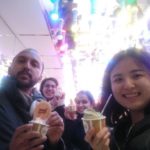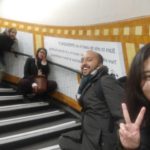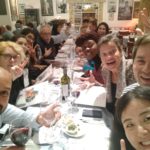At a Glance, youth engagement in the Lancet Standing Commission
By Shanshan He, Youth Network Member of the Lancet Standing Commission.
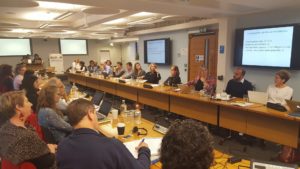
Imagine how it feels to sit around the table with a group of experts who speak fast, in different accents with countless medical terminology and acronyms. You may be nervous, and miss important information or perhaps you don’t always understand what is going during the discussion. You might be worried about sounding silly or childish, so you are afraid to speak up. This may be an image or memory that easily comes to mind. However, this was not what happened with the Youth Network Members who attended the final planning meeting of the Lancet Standing Commission on adolescent health and wellbeing in a chilly London in January. Here, I am going to shed light on what a “mysterious” academic meeting looks like and share our experience of participating at the London meeting.
Here, there, youth engagement and participation is EVERYWHERE…
Five of the Youth Network Members and one of our youth mentors arrived in London three days ahead of the Commission meeting. Why so early? We scheduled a one-day meeting for the Youth Network Members to discuss and finalise the Youth Network work plan, and two days to join the inequalities working group discussion that was led by Terry McGovern, Harriet and Robert H. Heilbrunn Professor and Chair Population and Family Health at the Columbia University Medical Center. Then, we attended the two-day Standing Commission meeting. What a long and rich week!
First, let me briefly explain our role as Youth Network Members of the Standing Commission. Some people might think we are here to provide a youth perspective on the issues discussed. That is true and important, but it is not the only thing we plan to do with the Commission. Our first and foremost goal is to be the bridge between young people and the academic world. Acting as a youth voice within the Commission and in return, promoting what has been discussed and produced back to young people through our networks.
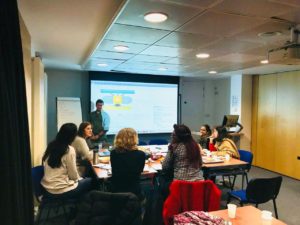
The discussion of the Youth Network’s work plan focused on building partnerships with adolescents and youth-focused organizations, and communications – specifically, what the youth network’s communication strategy should look like. Do not hesitate to contact us if you or your organization are interested in what we are doing!
On the second and third day, we joined the inequalities working group meeting. The day started with detailed introductions and discussions of what we have done, that brought us here. “You guys take me back to my teenage years,” said John Santelli (Professor of Population and Family Health and Pediatrics at Columbia University). The days were enriched with discussions on the different causes of inequality around the world and how the causes are interwoven with economics, education, race, religion, gender stereotypes, and historical factors. We acknowledged that sadly, inequalities are everywhere, and they severely impact the health and wellbeing adolescents’ globally. To take forward what was published in the former Commission report, we carefully selected five less-known cases that to date, have not been properly addressed – case study will be our research method – and we contributed to drafting a work plan for the inequalities working group.
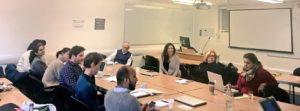
However, our presence was not merely limited to meetings. We were active participants, engaging with our new colleagues, introducing ourselves and expressing our interest in certain topics. The working group members helped us to contribute to the direction the group took – learning as well as practicing how to engage meaningfully. The process was intimidating, as the room was full of eminent scholars but the members treated us as equals and we tried our best to rise to the occasion.
Intersectionality: a broader map of the adolescent health movement
After three days’ of challenging intellectual debate, we arrived at the Commission meeting to hear and discuss presentations from each of the working groups on their proposed work plan. Some topics had been discussed at the previous meeting in New Delhi, while others were new – digital media, economics, demography and nutrition.
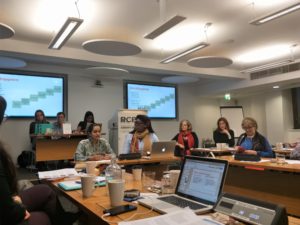
It is amazing to learn how different elements of our life are shaping our health and wellbeing. During the meeting, “intersectionality” was frequently mentioned and was a common theme through the discussions. Adolescent health and wellbeing is not a stand-alone topic, for instance, the development of technology is transforming the lifestyles of young people but yet, the use of digital media could be a double-edged sword. Concerns are rising about how digital media is affecting the health of adolescents and how ‘we’ should respond? The structure of society creates inequalities that affect access to universal health coverage. Would the adoption of social science research methods help, would it assist with innovative solutions? Economic theories may help prioritise our goals, construct conceptual frameworks, and provide useful techniques. These are just a few examples of the multidisciplinary nature of the adolescent health movement, and we are all expecting to see more ideas sparked as we move on.
The youth network had the opportunity to share their work plan which we had collectively worked hard on. The act of preparation, and presenting to a room full of seasoned researchers in itself is a huge learning experience. As a group, we feel extremely grateful to have access to the budding areas of research in adolescent health which have the potential to address some of the most pressing healthcare issues facing adolescents around the world. One thing I found magical about the research is that it links our individual lives to a much bigger picture and sometimes we can see how that reflects in data, seeing where we fit.
After all the meetings…
Even though the meetings were hard work, we still had fun together. Hanging out on the streets of London… enjoying fish and chips (and ice cream!) whilst joking and reminiscing upon busy days well spent.
To be a Youth Network Member of the Lancet Standing Commission – it connects you to friends in Canada to the North, New Zealand in the South, Zambia and Uganda on the African continent, and India on the Asian continent. We come from different time zones with different lives but whilst in London, we maximized the use of every minute to get to know each other and learn from each other’s experiences.
If you want to know more about us and our stories within the Lancet Standing Commission, stay in touch and see you next time!
